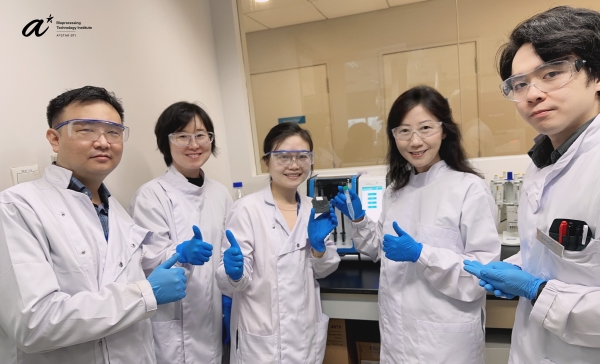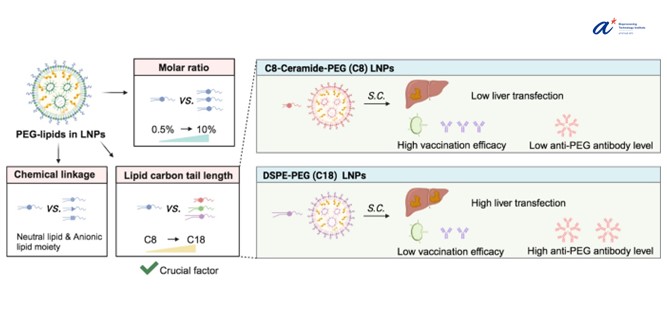Insights into LNP design for mRNA delivery

Science
Messenger RNA (mRNA) vaccines, such as those developed for COVID-19, must be protected and safely delivered into the body’s cells to function effectively. To facilitate this, scientists use fat-like particles called lipid nanoparticles (LNPs), which are composed of four lipid components. Among these components, polyethylene glycol-conjugated lipid (PEG-lipid), plays a crucial role in stabilising the nanoparticles and enhancing their circulation in the body, despite being present in small amounts. However, how the structure and amount of PEG-lipid influence the effectiveness of mRNA delivery have not been fully understood. In our study, we investigated different types of PEG-lipid to understand how structural modifications— such as the length of the lipid tail or the amount used—affect the delivery, location, and effectiveness of the mRNA in the body. We found that excessive amounts of PEG-lipid reduced mRNA delivery efficiency. Additionally, certain types of PEG-lipids facilitated targeted delivery to specific organs, such as the liver or lymph nodes1. These findings can help scientists design better mRNA vaccines in the future.
Societal Impact
Our findings can benefit both the pharmaceutical industry and the public by improving the design of mRNA vaccines and therapies, making them more effective, safer, and potentially more affordable. By understanding how different types and amounts of PEG-lipids influence mRNA delivery and where it goes in the body—such as to the liver or lymph nodes—we can design LNPs that better target specific tissues, enhance vaccine efficacy, and reduce unwanted immune responses. For the industry, this means more efficient vaccine development and the ability to tailor treatments for various diseases. For the public, this could lead to vaccines and treatments that work better, have fewer side effects, and are more accessible in the future.
Technical Summary
In this study, the impact of PEG-lipid structural parameters on the performance of mRNA-loaded LNPs (mRNA-LNPs) was systematically evaluated using a library of 48 distinct formulations. Key variables included PEG-lipid molar content, lipid tail length, and the chemical linkage between the PEG and lipid moieties. The LNPs were assembled via both manual and microfluidic mixing methods, followed by characterization of encapsulation efficiency, in vitro translation, biodistribution, and in vivo immunogenicity. The data revealed that PEG-lipid content above 3 mol% substantially reduced mRNA encapsulation and translation efficiency, particularly in manually mixed systems. The chemical linker type had minimal influence, but the lipid tail length had a consistent and significant effect across both preparation methods.
Biodistribution studies in mice demonstrated that LNPs containing ALC-0159 (C14 tail) or C16-Ceramide-PEG preferentially targeted the liver, while C8-Ceramide-PEG-based LNPs showed enhanced accumulation in lymph nodes. Functionally, C8- and C16-Ceramide-PEG LNPs supported comparable in vivo mRNA vaccine efficacy to ALC-0159-based LNPs in a SARS-CoV-2 Delta spike protein model, whereas DSPE-PEG (C18 tail) LNPs resulted in inferior immune responses. Additionally, C16-Ceramide-PEG and DSPE-PEG LNPs elicited stronger anti-PEG antibody responses compared to C8-Ceramide-PEG and ALC-0159, suggesting potential immunogenicity concerns with longer lipid tails. None of the tested LNPs induced significant toxicity in mice. These results highlight C8-Ceramide-PEG as a promising PEG-lipid component for mRNA-LNP formulations due to its favorable targeting, efficacy, and immunogenicity profile.

Figure 1. Effect of PEG-lipid on mRNA biodistribution, vaccination efficacy and immunogenicity.
Extracted from Ref. 1 with permission from Elsevier.
References
1. Li Zhang, Brandon Yi Loong Seow, Ki Hyun Bae, Yue Zhang, Kuo-Chieh Liao, Yue Wan, Yi Yan Yang. Role of PEGylated lipid in lipid nanoparticle formulation for in vitro and in vivo delivery of mRNA vaccines. J. Control. Release 2025, 380, 108-124.
A*STAR celebrates International Women's Day

From groundbreaking discoveries to cutting-edge research, our researchers are empowering the next generation of female science, technology, engineering and mathematics (STEM) leaders.
Get inspired by our #WomeninSTEM
.png?sfvrsn=1a7df424_3)